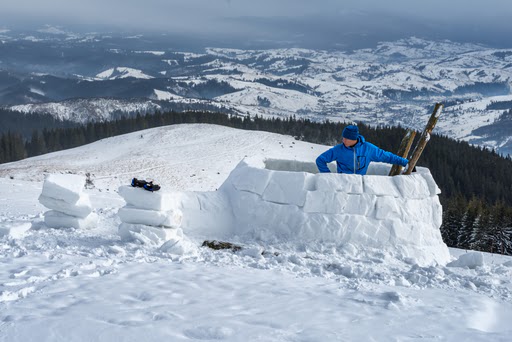An igloo maintains warmth by trapping the body heat. Igloos are constructed using compacted snow. About 95% of this snow consists of trapped air, which serves as an effective insulator. This insulation prevents the dissipation of body heat, thus keeping us warm.
Imagine yourself walking in the snowy expanse of the Arctic tundra. Naturally, you start feeling cold due to the icy, chilling wind. Desperately searching for shelter, all you see is pristine white snow. Finally, you stumble upon an igloo, also made of snow! You enter the structure, and to your surprise, you begin to feel warm after some time!
An igloo, made from the same freezing snow that causes coldness, is remarkably proficient at keeping people warm. But how? How can something so cold make you feel warm?
Well, this is due to the remarkable properties of snow and the structure of an igloo.

Why Do We Feel Cold?
As the entire scenario with the igloo revolves around coldness and heat, let’s start by understanding the actual meaning of ‘hot’ and ‘cold’.
Heat is a form of energy that can be transferred from one body to another. Heat energy moves from areas of higher temperature to areas of lower temperature until both regions reach thermal equilibrium and have equal temperatures.
This transfer of heat can occur in three ways:
 Methods of heat transfer
Methods of heat transfer
- Conduction: In this process, heat is transferred through direct physical contact between objects. It does not involve the actual movement of matter, but thermal energy is transferred across adjacent molecules. If you touch a hot pan, your hands will get burned as heat is conducted from the pan to your hand.
- Convection: This is the primary method of heat transfer in fluids (liquids, gases). Heat is transferred through the movement of molecules based on their density. Warm air rises and cold air sinks due to convection.
- Radiation: Radiation is the transfer of heat in the form of electromagnetic radiation. It does not necessarily require a medium, so heat can be transferred through radiation even in a vacuum. We feel the warmth of sunlight because the sun transfers heat through space via radiation.
In essence, the terms ‘hot’ and ‘cold’ actually describe heat itself. Objects that lose heat become colder, while those that gain heat become warmer. So, when you feel cold, you are essentially losing heat.
An interplay of these three mechanisms keeps an igloo warm. Let’s take a look at how!
The Science Behind An Igloo
On a chilly morning, a relatively small piece of blanket can make us feel warm and cozy. A blanket does not produce any heat on its own and it is not something we would call ‘hot’, so how does it keep us warm? Simply by trapping our body heat and preventing it from escaping! A blanket itself is not warm; it only prevents the loss of our body heat.
An igloo operates on a similar principle. The igloo acts as a large blanket, confining a person’s body heat within its walls.

An igloo (Photo Credit: envato)
Inuits
Igloos are traditionally associated with the indigenous populations of the Arctic regions of Alaska, Canada, and Greenland, broadly referred to as the Inuits. They are temporary shelters created by the Inuits for use as winter homes or for hunting expeditions.
The key to a warm igloo lies in selecting the appropriate raw material, and in the Arctic, there are only two raw materials abundantly available – snow and ice.
Compressed Snow
An igloo is constructed using compressed snow. Compact hardened snow is an excellent heat insulator because snow is essentially semi-frozen water with about 95% trapped air. The air molecules trapped between the small ice crystals form air pockets, which act as effective insulators, preventing heat loss due to convection. Therefore, snow is the ideal material for building a warm home in the freezing Arctic environment.

Inuits building an igloo (Photo Credit: Wikimedia commons)
Unlike snow, ice is frozen water and does not contain many air pockets, making it a poor insulator. Thus, snow is preferred over ice for constructing igloos.
The type of snow used is equally important. Freshly fallen snow is brittle and powdery and cannot be used to build a sturdy structure. Therefore, igloos are made by cutting out hardened, compressed snow blocks from the ground.

Igloos are made of compressed snow blocks (Photo Credit: envato)
An experienced Inuit can construct an igloo from scratch in approximately an hour. All that is needed is a saw, snow, and a lot of skill and technique.
How Does An Igloo Keep You Warm?
The human body converts energy from the food we consume into heat energy. This heat energy is released from our body to the surrounding environment through conduction, convection, and primarily radiation. The escaped heat circulates within the igloo through convection and warms up some of the air inside.
Due to the fact that cold air is denser than warm air, the cold air settles at the bottom of the igloo, while the warm air rises towards the top of the structure. To accommodate this, the igloo floor is divided into terraces. The upper warm layer is where people sleep, the middle layer is for cooking and fires, and the sunken bottom floor serves as a cold sink.
The insulating snow walls prevent the loss of body heat and also protect people from the cold winds outside.
Thus, an igloo utilizes the heat lost from our bodies to regulate the temperature inside.
Does The Structure Of An Igloo Affect Its Warmth?
The structure of an igloo also plays a significant role in retaining heat inside.
The small door and the narrow tunnel leading to the central dome of the igloo have their own importance. The small sunken right-angled tunnel functions as a cold sink, while also preventing snowstorms and cold winds from directly entering the main area of the igloo.
As previously discussed, an igloo is divided into terraces or chambers. The main chamber consists of an upper platform for sleeping and a lower platform for other tasks. The inside of the chamber is also covered with sealskin to improve insulation. In addition to the main chamber, there is an anterior chamber that serves as a cold sink and a storage area for preserving food.
 The Structure of an Igloo (Photo Credit : Albert Stephen Julius/Shutterstock)
The Structure of an Igloo (Photo Credit : Albert Stephen Julius/Shutterstock)
Have you ever wondered why igloos are shaped like domes? Why aren’t there any square igloos? Well, the shape of the igloo determines its stability. The dome of an igloo is in the shape of a catenoid. This shape provides structural stability and ensures that the igloo does not collapse or buckle under pressure.
Since snow does not provide the greatest stability, the catenoid-shaped dome distributes pressure evenly and enhances the overall strength of the igloo. In fact, a properly constructed igloo can support the weight of a person standing on it!
 Interior of an Igloo (Photo Credit : Wikimedia commons)
Interior of an Igloo (Photo Credit : Wikimedia commons)
Therefore, proper implementation of construction techniques is crucial for keeping the igloo warm and comfortable.
How Warm Is An Igloo?
If constructed correctly, an igloo can create a temperature difference of about 40oC between its interior and the external environment simply through the use of body heat.
In a study conducted by Rich Holihan and his colleagues, it was discovered that inside an igloo, near the bodies of the people, the temperature was approximately 36oC (310K). In the air surrounding the people, the temperature dropped to nearly 16oC (290K), and at the far end near the walls of the igloo, the temperature was around 1oC (275K). Additionally, if there are more people inside the igloo, it becomes even warmer.
Although 16oC or 1oC may not be a “cozy” temperature, considering that the temperature of arctic terrains can reach a staggering -40oC to -50oC, an igloo does an excellent job of regulating the temperature. Thus, for individuals living in sub-zero temperatures, an igloo serves as a warm and comfortable dwelling.
Even animals in Arctic regions take advantage of the insulating properties of snow by digging holes to stay warm.
 A polar bear inside a snow den. (Photo Credit : Sergey Uryadnikov/Shutterstock)
A polar bear inside a snow den. (Photo Credit : Sergey Uryadnikov/Shutterstock)
Summary
The Inuits’ ability to create a warm and stable structure like an igloo without understanding the scientific principles behind it is truly remarkable. The igloo is a prime example of vernacular architecture.
With the knowledge of the science behind igloos, if you ever find yourself stranded in a snowy environment without shelter, you can construct a dome-shaped igloo using snow blocks to keep yourself warm.
